Bell Towers Saint-Mark | Greci | St.Giorgio | Formosa | Apostoli | Stefano | Vigna | Felice |
The Campanile of San Francesco della Vigna in Venice - 69 metres
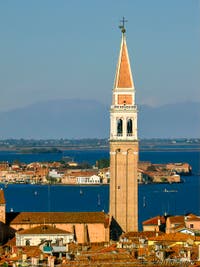
San Francesco della Vigna It's tall, slender and elegant. The campanile of San Francesco della Vigna is one of the most beautiful campaniles in Venice.
Because of its slenderness and slender size, Théophile Gautier called it " the red needle of San Francesco della Vigna ".
The campanile of San Francesco della Vigna was built between 1571 and 1581, under the direction of Master Bernardino Ongarino, who was in fact buried at his feet, in thanks for his work and as a tribute to the passion he had shown for this beautiful work.
The campanile of San Francesco della Vigna was built a few years before that of Greci, built between 1587 and 1592.
And it was precisely the same Bernardino Ongarin (or Ongarino) who built the campanile of San Giorgio dei Greci.
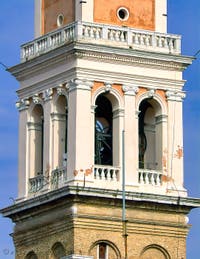
San Francesco della Vigna A campanile, however, which began to lean as soon as it was built.
Like many campaniles in Venice, including the famous campanile of St. Mark, campaniles erected from the 16th century onwards were most often replacements for previous campaniles, following their collapse.
The campanile of San Francesco della Vigna built by Bernardino Ongarin was no exception and was built to replace the old campanile, dating from the XIIe century.
The previous campanile had in fact been almost completely destroyed by lightning in 1489.
The church therefore remained almost a century without a campanile.
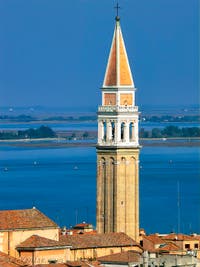
San Francesco della Vigna The name of the campanile, and of its church, comes simply from the fact that vines grew here at the time the land was ceded, in 1253, to the Franciscan friars, hence its full name : San Francesco della Vigna.
The campanile of San Francesco della Vigna is also one of the tallest in Venice by height, at 69 metres, placing it, along with the Campanile dei Frari, second only to that of St. Mark's.
Incidentally, thanks to this beautiful size, if you ever get the chance to take a boat trip on the Venice lagoon, you may be able to witness "the eclipse" of the campanile of St. Mark.
In fact, when sailing southwest of the island of Sant' Erasmo, between Sant'Erasmo and the island of Lazzaretto Nuvo, as the boat moves forward, the campanile of San Francesco della Vigna begins to hide the campanile of St. Mark, until it disappears altogether.
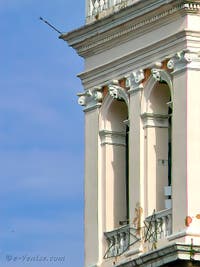
San Francesco della Vigna At first you get the impression of seeing the campanile of San Francesco della Vigna "in duplicate", then the two towers merge, with the body of San Marco being the first to be hidden, given the perspective effect.
Then the two pointed roofs with their spires come together to form one.
The campanile of San Marco disappears completely from the landscape ! Magical !
The campanile's location, right next to the Arsenal, then and still today a military zone, earned it some extra attention from the authorities of the time.
Thus, by a decree dated 15 April 1581, the year its construction was completed, it was decreed that the two arches of the campanile cell facing the Arsenal should be walled up.
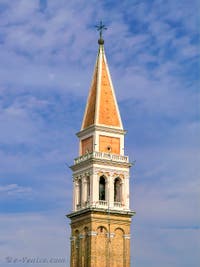
San Francesco della Vigna The official motivation was to prevent incendiary projectiles being fired at the Arsenal from the top of the campanile, but the fear of espionage was just as present.
From the campanile of San Francesco della Vigna, it was very easy to observe the Arsenal's construction sites and thus steal some of the Serenissima's military secrets at a time when wars were being fought one after the other.
Fortunately, however, the two arcades, made of Istrian stone, like the entire belfry of the campanile, were later demolished and our pretty campanile now has all its eyes again and has thus regained the right to look out over its famous military neighbour.
In 1659, the Campanile's spire was restored following heavy storms. But much more seriously, on September 21, 1757, the Campanile of San Francesco della Vigna was once again struck by lightning.
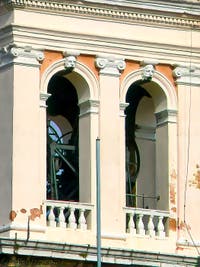
San Francesco della Vigna And his setbacks didn't stop there.
In fact, just a year later, on 21 September 1758, it was a flaming wick from the Arsenal's construction sites that almost destroyed the campanile.
Finally, on the night of 18 to 19 August 1771, the storm and lightning that hit the campanile were so violent that its entire spire had to be rebuilt.
It was following this last disaster that in 1781, at the request of the Franciscan friars, the government of the Republic had a lightning rod installed on the campanile of San Francesco della Vigna.
It has to be said that, in addition to its function as the church's bell tower, this bell tower had a maritime role as a superb landmark for the boats that came to dock in the port.
It was therefore important for the Serenissima to protect it for this reason too.
Unfortunately, you can't visit the campanile of San Francesco della Vigna, so you'll have to make do with looking at it and admiring its fine presence, its superb slender appearance on the edge of the lagoon.
Bell Towers Saint-Mark | Greci | St.Giorgio | Formosa | Apostoli | Stefano | Vigna | Felice |
Back to Top of Page

